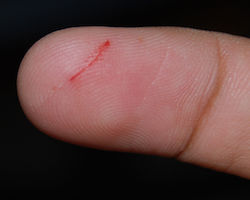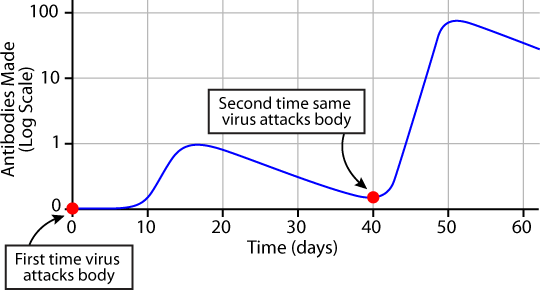How Do Immune Systems Work?

You peek inside the room and see your younger brother there, sick in bed. His face is covered in red dots, and your dad has made him wear socks on his hands so he won’t scratch. You remember when you went through this—he has chicken pox. Chicken pox is an infection caused by a virus. But because you were already exposed, you don’t have to worry too much about catching it again. You walk into the room and hand your brother a glass of juice.
Why does having had the virus protect you from catching it a second time? Because part of your body’s defense system has a memory. It learns what you are exposed to and can fight it off much faster if you are ever exposed again.
Every animal has to defend itself against bacteria, viruses, and other pathogens in the world. They have one main defense system that help with that: the immune system.
The Safety of Skin

Skin is a barrier that covers every inch of the outside of your body. It protects you against scratching more delicate internal tissues, and it helps keep dangerous things out of your body. Skin (or other integument) is the first step to protecting your body from pathogens. Millions of immune cells live on and in your skin, fighting off potential invaders. The same is true for other animals. Skin is the first line of innate immune defense, and all animals. All animals have a skin or covering of some kind, and it is the first line of innate immune defense.
However, skin or other coverings can be damaged, and there are other ways pathogens can sneak into the body, like in food. What happens when a pathogen gets past the outer layer of protection of skin? Well, that’s when the real fight begins.
Your Main Defenders: The Innate Immune System
You see a feral cat outside, crouching down ever so slowly. It raises its rear end up a bit, moving it back and forth, and rushes forward, trying to pounce on a harmless snake. The snake moves away just a little too late, and the cat grabs its tail. The snake thrashes around, and breaks free of the cat’s claws, disappearing under some wood. But it wasn’t quite fast enough to avoid injury—the snake is bleeding from a small cut on its tail.

Hidden under the wood, the snake is safe from the cat, but another fight has just started. As platelets rush around the snake’s body to find the cut and stop the bleeding, some pathogens have snuck into the wound. As soon as they can, these invaders start multiplying, trying to set up camp in the snake’s body. And without even knowing what type of pathogen it’s up against, the snake’s body starts to fight back.
First, proteins that are in the blood will start to grab on to the invaders, trying to stop them from moving, and marking them as dangerous. White blood cells near the infection site will take notice. They will call other cells to come help, as they all try to eat or destroy the invading cells. As this fight is going on, a message is sent to the snake’s immune system, letting it know it’s under attack.
This wakes up the innate immune system to full force. It starts making more and more white blood cells, to go and help defend the snake’s body. The first wave of new white blood cells are sent out to fight. These white blood cells are also known as non-specific immune cells. They are called non-specific because they fight anything that is foreign, not just certain cell types. All the movement of cells into the area will cause the skin around the wound to swell and turn hot.
In most cases, it takes several days for a full immune response to take effect. With some invaders, that is too much time, and your body then has a lot of difficulty fighting it off. Because of this, most animals also have an immune memory. If it gets attacked by an invader once and manages to fight it off, it remembers exactly how to kill it, so it can do it faster the next time.
Deeper Defense: The Adaptive Immune System
Luckily for the snake, the toughest of the pathogens that enter its body aren’t new. The snake has been infected by them before. This means that other cells called B-cells get involved, and start making antibodies for that specific invader. Antibodies are the best defense for a specific threat. The snake’s body remembered exactly what antibodies fought off these invaders, and it starts making more of them, fast.

This “memory” part of the defense system is adaptive immunity. The immune system “adapts” to the threats around it, learning how to fight off attackers more quickly. It’s also called acquired immunity (“acquire” means to “get” something), because this part of the immune system has to learn or develop as an animal grows.
Adaptive immunity is thought to use up more energy than the innate system. But there is a huge benefit to this response. It can act much faster than the innate immune system, saving days or even weeks off of the response time. This means that it has a much better chance of fighting off invaders, before their numbers get to be too big.
After just a few days, the adaptive defense system releases the antibodies. The antibodies latch on to the invader, so that the white blood cells can finally finish them off. After the fight is over, other cells come by to clean up all the dead cells. Then, the immune system quiets down again, waiting, until the next invasion.
A Shared Fight

For a long time, it was thought that only vertebrates had an adaptive immune system. But we are finding that many other animals also have memory-based immunity. Even some insects have been found to have an immune system that can adapt and remember.
Across animals, we see a huge range of strength in immune function. At the top end, we see alligators, who are super-fighters against bacteria and some cancers. At the bottom end, we see some invertebrates, that don’t seem to have memory-based immunity, as far as we can tell. There is still so much to learn about immune function across all organisms. And what we are learning from their immune systems may one day help us fight some of our most dangerous microscopic attackers.
Read more about: Focusing on Physiology
Bibliographic details:
- Article: Immune Systems
- Author(s): Dr. Biology
- Publisher: Arizona State University School of Life Sciences Ask A Biologist
- Site name: ASU - Ask A Biologist
- Date published:
- Date accessed:
- Link: https://askabiologist.asu.edu/immune-function
APA Style
Dr. Biology. (). Immune Systems. ASU - Ask A Biologist. Retrieved from https://askabiologist.asu.edu/immune-function
Chicago Manual of Style
Dr. Biology. "Immune Systems". ASU - Ask A Biologist. . https://askabiologist.asu.edu/immune-function
Dr. Biology. "Immune Systems". ASU - Ask A Biologist. . ASU - Ask A Biologist, Web. https://askabiologist.asu.edu/immune-function
MLA 2017 Style

All animals have some kind of immune system, from humans to shrimp and worms. We are also learning that more animals have memory-based immunity than we thought.
Be Part of
Ask A Biologist
By volunteering, or simply sending us feedback on the site. Scientists, teachers, writers, illustrators, and translators are all important to the program. If you are interested in helping with the website we have a Volunteers page to get the process started.

